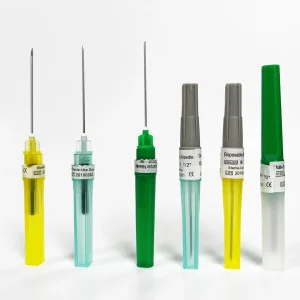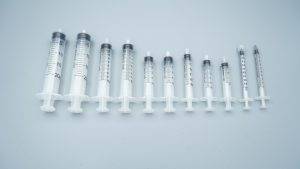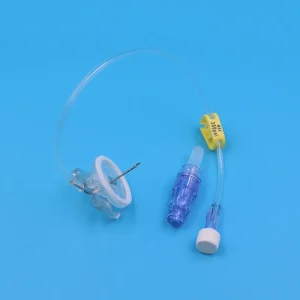Understanding the Critical Differences Between Medical and Veterinary Injection Equipment
Have you ever wondered about the difference between syringes for humans and veterinary syringes? While they may look similar at first glance, the distinction between human medical syringes and animal syringes involves critical safety standards, regulatory requirements, and design specifications. This comprehensive guide explores whether these injection devices can be used interchangeably and what you need to know about each type.
Can Humans Use Veterinary Syringes? The Risks Explained
Technical Feasibility vs. Medical Safety
From a purely mechanical standpoint, veterinary syringes function similarly to human medical syringes—both use a plunger mechanism to deliver medication through a needle. However, technical possibility does not equal medical safety.
Critical Risk Factors of Using Animal Syringes on Humans
1. Sterilization Standards Differ Significantly
Human medical syringes must comply with stringent FDA (or equivalent international) medical device regulations, requiring:
- Validated sterilization protocols (ethylene oxide gas or gamma radiation)
- Sterility Assurance Level (SAL) of 10⁻⁶ (less than one-in-a-million chance of contamination)
- Hermetically sealed, tamper-evident packaging
- Traceable lot numbers and expiration dates
In contrast, veterinary syringes follow veterinary-grade standards, which may not meet human medical-grade sterility requirements. Think of it this way: restaurant kitchenware is clean, but surgical instruments require hospital-grade sterilization—both serve their purpose, but they’re not interchangeable.
2. Biocompatibility and Material Safety
Syringes for humans undergo rigorous biocompatibility testing per ISO 10993 standards, ensuring:
- No cytotoxic effects (won’t damage human cells)
- No pyrogenic reactions (won’t cause fever)
- No allergen leaching from plastics or rubber components
- USP Class VI material certification
Veterinary injection equipment may use materials not certified for human use, potentially containing plasticizers or additives that could trigger adverse reactions in humans.
3. Precision and Accuracy Requirements
Human medical syringes feature:
- Graduation marks accurate to ±5% or better
- Volumes ranging from 0.3mL (insulin syringes) to 60mL
- Clear, readable measurements for precise dosing
Animal syringes, especially those designed for livestock, may have coarser graduations since large animals tolerate wider dosing margins.
Legal and Regulatory Consequences
Using veterinary syringes on humans violates medical device regulations in virtually all jurisdictions:
- Healthcare providers risk license revocation
- Potential criminal liability for negligence
- No insurance coverage for complications
- Violation of Good Manufacturing Practice (GMP) standards
Can Animals Use Human Medical Syringes? The Safer Alternative
The Answer: Yes, and Often Preferable
Unlike the reverse scenario, using human medical syringes for veterinary applications is generally safe and even advantageous—particularly for companion animals.
Why Human Syringes Work Well for Veterinary Use
Using higher-standard equipment in lower-requirement settings poses minimal risk. It’s like using surgical-grade instruments for routine procedures—you’re exceeding, not compromising, safety standards.
Key Advantages:
- Superior sterility assurance reduces infection risk
- Precise measurement crucial for small animals (cats, dogs, exotic pets)
- Higher-quality materials mean less breakage
- Better needle sharpness reduces pain and tissue trauma
Practical Considerations:
- Cost factor: Human medical syringes typically cost 2-3x more than veterinary equivalents
- Needle gauge selection: Large animals (horses, cattle) may require specialized heavy-duty needles not standard in human medical syringes
- Volume capacity: Livestock vaccinations may need 50-100mL syringes uncommon in human medicine
Real-World Veterinary Practice
Many veterinary clinics, especially those specializing in small animal care, routinely use human-grade medical syringes. High-end veterinary hospitals often stock the same sterile injection equipment used in human hospitals to ensure optimal patient safety.
Why Interchangeability Isn’t Recommended: The Science Behind the Standards
The Medical Safety Pyramid Principle
Healthcare follows a “zero-tolerance” approach to preventable harm. Consider this:
- If veterinary syringes cause infection in 1 out of 1,000 uses, that 0.1% failure rate is unacceptable in human medicine
- The human immune system reacts strongly to foreign contaminants—even trace bacteria or chemical residues can trigger serious complications
- Medical standards exist because the stakes are human lives
Manufacturing and Quality Control Differences
Human Medical Syringes:
- Produced in ISO Class 7 (Class 10,000) cleanrooms or better
- Undergo 100% visual inspection for defects
- Subject to FDA 510(k) clearance or equivalent approval
- Batch testing for pyrogenicity and sterility
- Rigorous quality management systems (ISO 13485)
Veterinary Syringes:
- Manufactured to veterinary device standards (less stringent)
- May undergo sampling inspection rather than 100% inspection
- Different regulatory pathways with fewer testing requirements
- Focus on durability over sterility in some applications
The Cost of Compromise
Healthcare economics might tempt cost-cutting, but using veterinary injection equipment for humans creates:
- Infection risk: Potential sepsis, abscess formation, or bloodborne pathogen transmission
- Legal liability: Malpractice claims and regulatory penalties
- Patient trust erosion: Undermines confidence in healthcare providers
- Long-term costs: Treating complications far exceeds initial savings
Emergency Situations: When Standard Rules Don’t Apply
Life-or-Death Scenarios
In genuine emergencies—wilderness accidents, natural disasters, conflict zones—when human medical syringes are unavailable, can veterinary syringes be used? The answer requires careful risk assessment.
Emergency Use Decision Framework
Before using animal syringes in emergencies, evaluate:
- Is injection truly necessary RIGHT NOW?
- Can the patient survive until proper medical equipment arrives?
- Are oral, topical, or other administration routes viable?
- Is the medical emergency life-threatening without immediate injection?
- Risk-benefit calculation
- Death or permanent disability without treatment? Consider emergency use
- Condition manageable for hours? Wait for proper equipment
- Alternative treatments available? Choose safer options
Emergency Sterilization Protocols for Veterinary Syringes
If you must use veterinary injection equipment in a crisis:
Step 1: Maximum Possible Sterilization
- Boiling: Immerse syringe components in rolling boil for 10-15 minutes (if heat-resistant)
- Chemical sterilization: Soak in 70-75% isopropyl alcohol for minimum 30 minutes
- Betadine/iodine solution: Alternative if alcohol unavailable (2% solution, 20-minute soak)
Warning: Boiling may warp plastic components of some veterinary syringes. Test with expendable unit if possible.
Step 2: Injection Site Preparation
- Cleanse with alcohol swabs (concentric circles, working outward)
- Apply povidone-iodine if available
- Allow antiseptic to dry completely (critical for effectiveness)
- Avoid touching the prepared area
Step 3: Safer Injection Techniques
- Prefer intramuscular (IM) over intravenous (IV): IM injection has lower complication risk
- Target large muscle groups: Deltoid (shoulder), vastus lateralis (thigh), or gluteus (buttock)
- Avoid neurovascular bundles: Never inject near visible blood vessels or nerve pathways
- Aspirate before injecting: Pull plunger back to check for blood (indicates vessel puncture)
Step 4: Post-Injection Monitoring
- Seek professional medical care immediately after crisis stabilization
- Inform healthcare providers about non-medical-grade syringe use
- Monitor injection site for 72 hours for:
- Redness or warmth (infection signs)
- Swelling or abscess formation
- Fever or systemic symptoms
- Prophylactic antibiotics may be warranted—medical decision only
Documentation Is Critical
In emergency situations, record:
- Type of veterinary syringe used (manufacturer, lot number if available)
- Sterilization method employed
- Time, date, and reason for emergency use
- Medication administered (name, dose, route)
This information is vital for subsequent medical care and legal protection.
Why Separate Veterinary and Human Medical Syringes Exist: Design Philosophy
Animal-Specific Requirements Drive Veterinary Syringe Design
1. Extreme Size Variation in Veterinary Patients
Veterinary syringes must accommodate:
- Micro-doses for hamsters, birds, reptiles (0.1-1mL precision)
- Macro-doses for horses, cattle, elephants (50-250mL capacity)
- This range far exceeds what human medical syringes must cover
2. Anatomical Differences Require Specialized Needles
- Thick-skinned animals (pigs, cattle): Require 14-16 gauge needles (much thicker than human standards)
- Heavy fur/feathers: Needles must penetrate dense coats without bending
- Tough fascia: Livestock connective tissue demands stronger needle construction
3. Behavioral Challenges in Veterinary Medicine
Animal syringes often feature:
- Reinforced barrels: Withstand crushing if animal moves suddenly
- Locking mechanisms: Prevent accidental injection during patient struggle
- Ergonomic grips: Enable one-handed operation while restraining animal
- Automatic syringes: Multi-dose applicators for herd vaccination (reduce handling time per animal)
4. Veterinary-Specific Applications
- Dose syringes: Oral medication delivery (paste wormers, supplements)
- Implant guns: Subcutaneous pellet placement (hormones, identification chips)
- Teat cannulas: Mastitis treatment in dairy cattle
- Continuous flow syringes: Mass vaccination in commercial farming
Economic Considerations in Veterinary vs. Human Healthcare
Veterinary medicine operates under different economic constraints:
- Cost-effectiveness is paramount in livestock production
- Veterinary syringes must balance quality with affordability
- Reusable glass syringes still used in some veterinary settings (properly sterilized between uses)
- Human medical syringes are exclusively single-use disposable (standard since 1950s)
The Broader Lesson: “Close Enough” Doesn’t Apply to Medical Devices
Breaking the “Good Enough” Mindset
This human medical syringe vs. veterinary syringe discussion illuminates a crucial principle: in healthcare, similar-looking doesn’t mean equivalent.
Seemingly minor differences carry major consequences:
- A slightly less sterile animal syringe could introduce fatal pathogens
- A less precise graduation could cause overdose or underdose
- An unapproved material could trigger anaphylaxis
Respecting Professional Boundaries
Do NOT:
- Give human medications to pets without veterinary guidance
- Give veterinary medications to humans
- Assume “it’s just a needle” makes it interchangeable
- Purchase prescription medications across species lines
DO:
- Consult licensed veterinarians for animal health
- Consult licensed physicians for human health
- Use properly labeled, species-appropriate medical supplies
- Understand that regulations exist for your protection
Value of Emergency Preparedness Knowledge
Understanding these distinctions empowers you to:
- Assess emergency situations realistically
- Make informed risk-benefit decisions when no ideal options exist
- Minimize harm when using suboptimal equipment unavoidably
- Recognize when professional help is non-negotiable
Conclusion: Safety Standards Exist for Good Reason
The differences between human medical syringes and veterinary syringes reflect modern medicine’s commitment to safety. While veterinary injection equipment serves animals well, it doesn’t meet the standards required for human use.
Key Takeaways:
- Human medical syringes undergo stricter sterilization, material testing, and quality control than veterinary syringes
- Using animal syringes on humans risks infection, allergic reactions, and legal consequences
- Using human medical syringes for animals is safe and often preferred, especially for pets
- In genuine emergencies, veterinary syringes can be used for humans with proper sterilization and extreme caution
- Species-specific medical equipment exists because different standards and needs apply
When in doubt, always consult qualified healthcare professionals—physicians for humans, veterinarians for animals. Your health and your pet’s health deserve the appropriate standard of care, not shortcuts that save pennies but risk lives.
Medical Disclaimer: This article provides educational information only and does not constitute medical or veterinary advice. All injection procedures should be performed by licensed healthcare professionals or veterinarians using appropriate, approved medical equipment. Never attempt self-injection or animal treatment without proper training and supervision.





